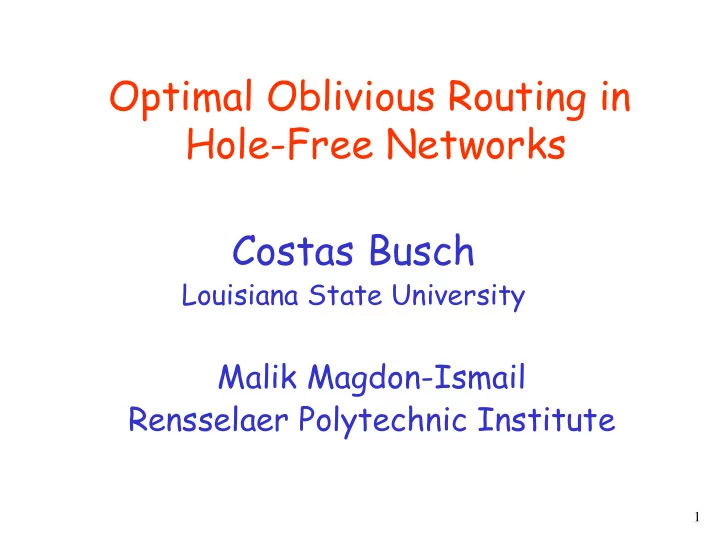

Optimal Oblivious Routing in Hole-Free Networks Costas Busch Louisiana State University Malik Magdon-Ismail Rensselaer Polytechnic Institute 1
Routing: choose paths from sources to destinations v 3 u 1 u v 2 2 u 3 v 1 2
Edge congestion Node congestion C C edge node maximum number of maximum number of paths that use any node paths that use any edge 3
Length of chosen path Stretch= Length of shortest path 12 stretch 1 . 5 shortest path 8 u v chosen path 4
Oblivious Routing Each packet path choice is independent of other packet path choices 5
Path choices: 1 q , , q k Probability of choosing a path: Pr[ i q ] k Pr[ ] 1 q i i 1 q 1 q 2 q 3 q 4 q 4 q 5 6
Benefits of oblivious routing: • Distributed • Needs no global coordination • Appropriate for dynamic packet arrivals 7
Hole-free network 8
Our contribution in this work: Oblivious routing in hole-free networks Constant stretch Small congestion stretch O ( 1 ) node * C O ( C log n ) node 9
Holes 10
Related Work Valiant [SICOMP’82]: First oblivious routing algorithms for permutations on butterfly and hypercube butterfly butterfly (reversed) 11
Maggs, Meyer auf der Heide, Voecking, Westermann [FOCS’97]: d-dimensional Grid: * C O d C log n edge edge Lower bound * log C n edge C for oblivious routing: edge d 12
Arbitrary Graphs (existential result): Racke [FOCS’02]: * 3 C O C log n edge edge Racke [STOC’08]: * C O C log n edge edge Constructive Results: Azar et al. [STOC03] Harrelson et al. [SPAA03] Bienkowski et al. [SPAA03] 13
General Approach: Hierarchical clustering 14
General Approach: Hierarchical clustering 15
At the lowest level every node is a cluster 16
source destination 17
Pick random node 18
Pick random node 19
Pick random node 20
Pick random node 21
Pick random node 22
Pick random node 23
Pick random node 24
25
Problem: Big stretch Adjacent nodes may follow long paths 26
An Impossibility Result Stretch and congestion cannot be minimized simultaneously in arbitrary graphs 27
Example graph: ( n ) Each path has length n paths n nodes Length 1 Destination Source of of all packets n packets 28
1 Stretch = n Edge congestion = packets in one path n 29
n Stretch = Edge congestion = 1 1 packet per path 30
Result for Grids: Busch, Magdon- Ismail, Xi [TC’08] * C O d C log n edge edge 2 stretch ( ) O d For d=2, a similar result given by C. Scheideler 31
Special graphs embedded in the 2-dimensional plane: Busch, Magdon-Ismail, Xi [SPAA 2005]: Constant stretch Small congestion stretch O ( 1 ) node * C O ( C log n ) node * C O ( C log n ) edge edge degree 32
Embeddings in wide, closed-curved areas 33
Graph models appropriate for various wireless network topologies Transmission radius 34
Basic Idea source destination 35
Pick a random intermediate node 36
Construct path through intermediate node 37
However, algorithm does not extend to arbitrary closed shapes 38
Our contribution in this work: Oblivious routing in hole-free networks 39
Approach: route within square areas node * C O ( C log n ) stretch O ( 1 ) node 40
grid n n 41
simple area in grid (hole-free area) 42
Hole-free network 43
Canonical square decomposition 44
Canonical square decomposition 45
Canonical square decomposition 46
Canonical square decomposition 47
48
49
Shortest path v u 50
Canonical square sequence v u 51
A random path in canonical squares v u 52
Path has constant stretch v u 53
Random 2-bend paths or 1-bend paths in square sequence 54
Recommend
More recommend